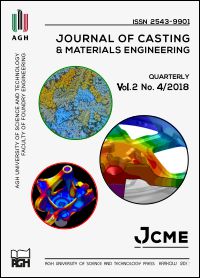New Possibilities in Thermal Analysis of Molding Materials
DOI:
https://doi.org/10.7494/jcme.2018.2.4.67Abstract
Molding material-related studies within the research activities concerning foundry technology have always been limited despite the significant effect of molding mixtures on the quality of cast parts. One reason behind this trend is the difficulty in interpreting the results of such complex systems like molds and cores. This paper provides a new possibility for studying the heat-absorption performance of materials used as molding media in metal casting processes. By further developing the Fourier thermal analysis method of cores and molds introduced by earlier authors, the investigation of unbonded sand has become available. The heat-absorption properties of the components can be hereby separated and studied respectively. Thermal analyses were performed on sphere-shaped resin-bonded cores with various binder levels as well as on unbonded sand samples. The temperature data collected from two points of the samples were then used for the calculation of the novel thermophysical properties. The results revealed not only quantitative but qualitative differences in the characteristics of the binder decomposition processes, providing a deeper understanding on the thermal behavior of molding materials. The outcome of the research provides more-accurate data, which is the key for the improved simulation of casting processes.
Downloads
References
Nowak D. (2017). Determination of binder content in traditional sandmixes by microwave method. Journal of Casting & Materials Engineering, 1(4), 80–84. Retrieved from http://dx.doi.org/10.7494/jcme.2017.1.4.80.
Stachowicz M., Paduchowicz P. & Granat K. (2017). Impact of density degree and grade of inorganic binder on behavior of molding sand at high temperature. Journal of Casting & Materials Engineering, 1(3), 64–69. Retrieved from http://dx.doi.org/10.7494/jcme.2017.1.3.64.
Holtzer M., Żymankowska-Kumon S., Kmita A. & Dańko R. (2015). Emission of BTEX and PAHs from molding sands with furan cold setting resins containing different contents of free furfuryl alcohol during production of cast iron. China Foundry, 12(6), 446–450.
Renhe H., Hongmei G., Yaoji T. & Qingyun L. (2011). Curing mechanism of furan resin modified with different agents and their thermal strength. China Foundry, 8(2),161–165.
Grabowska B., Kaczmarska K., Bobrowski A., Żymankowska-Kumon S., Kurleto-Kozioł Ż. (2017). TG-DTG-DSC, FTIR, DRIFT, and Py-GC-MS studies of thermal decomposition for poly(sodium acrylate)/dextrin (PAANa/D) – new binder BioCo3. Journal of Casting & Materials Engineering, 1 (1), 27–32. Retrieved from http://dx.doi.org/10.7494/jcme.2017.1.1.27.
Grabowska B., Malinowski P., Szucki M. & Byczyński L. (2016). Thermal analysis in foundry technology. Journal of Thermal Analysis and Calorimetry, 126(1), 245–250. Doi:10.1007/s10973-016-5435-5.
Grabowska B., Hodor K., Kaczmarska K., Bobrowski A., Kurleto-Kozioł Ż. & Fischer C. (2017) Thermal analysis in foundry technology: Part 2. TG-DTG-DSC, TG-MS and TG-IR study of the new class of polymer binders BioCo. Journal of Thermal Analysis and Calorimetry, 130(1), 301–309. Doi: 10.1007/s10973-017-6506-y.
Malherbe G., Henry J.-F., El Bakali A., Bissieux C. & Fohanno S.(2012). Measurement of thermal conductivity of granular materials over a wide range of temperatures. Comparison with theoretical models. 6th European Thermal Sciences Conference (Eurotherm 2012). Journal of Physics: Conference Series, 395. Doi:10.1088/1742-6596/395/1/012081.
Solenicki G., Budic I. & Ciglar D. (2010) Determination of thermal conductivity in foundry mould mixtures. Metalurgija, 49(1), 3–7.
Zych J. & Mocek J. (2015) Destruction of moulding sands with chemical binders caused by the thermal radiation of liquid metal. Archives of Foundry Engineering, 15(4), 95–100. Doi: 10.1515/afe-2015-0087.
Svidró J.T., Diószegi A. & Tóth J. (2014). The novel application of Fourier thermal analysis in foundry technologies. Examination of degradation characteristics in resin-bound moulding materials. Journal of Thermal Analysis and Calorimetry, 115(1), 331–338. Doi: 10.1007/s10973-013-3289-7.
Svidró J.T., Diószegi A., Svidró J. & Ferenczi T. (2017). The effect of different binder levels on the heat absorption capacity of moulding mixtures made by the phenolic urethane cold-box process. Journal of Thermal Analysis and Calorimetry, 130(3), 1769–1777. Doi:10.1007/s10973-017-6611-y.
Łucarz M. (2015). Setting temperature for thermal reclamation of used moulding sands on the basis of thermal analysis. Metalurgija, 54(2), 319–322.
Downloads
Published
Issue
Section
How to Cite
Accepted 2018-12-07
Published 2018-12-22


